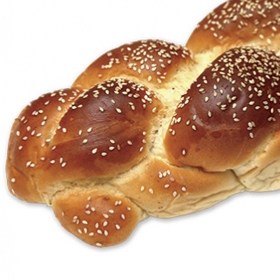When COVID closes her neighborhood bakery, making her own challah every week brings this writer a kind of comfort.

“Let your dough rise in a warm oven,” my sister advised over the phone. “And don’t rush the kneading.” I had just learned that my local bakery was shutting its doors due to COVID. Every Friday for more than seven years, I had rushed into that bakery to pick up two loaves of challah, traditional braided bread for the Jewish Sabbath, to enjoy with my family. Now, it seemed, I would need to bake the loaves myself. I could cook a savory omelet, but baking bread wasn’t my thing.
A quick trip to the grocery store left me yeastless (I wasn’t the only novice baker in town), so I struck a barter deal with my neighbor Alex. I gave him six cloves of garlic for his Puerto Rican sofrito in exchange for two teaspoons of yeast for my challah.
Then I got to work. Within minutes, my countertop was a mess of eggshells, flour, and oily measuring cups. I dissolved the yeast in warm water and watched it froth like cappuccino foam. I clanged around my cupboard for a whisk and eventually found it in the drying rack underneath a salad bowl. Tripping over Lego bricks, I added two teaspoons of salt. Slowly my dough began to take shape.
In the dining room next to my kitchen, I keep a photo of my late grandparents on their wedding day in 1946. My grandmother is draping her arm around my grandfather while playfully holding a lollipop in his mouth. Their faces are flooded with laughter, and on the table in front of them sits a resplendent challah in the shape of a fishtail braid. I knew my first attempt at homemade challah wouldn’t look anything like that. And it didn’t. But it wasn’t disastrous, either.
“Not bad!” my son chirped as he reached for a second warm hunk. A little bland, a bit dense, but satisfying.
The following week, when it became clear that my bakery wasn’t reopening anytime soon, I ordered four bricks of vacuum-packed yeast and 12 bags of unbleached flour that landed on my doorstep with a loud thump. I bought a collection of decorative glass jars to store an assortment of challah toppings—sesame seeds, za’atar, and pink Himalayan sea salt. Grasping for something to control in the storm of illness and death, I arranged all of the jars in my pantry and made sure the lids were airtight.
“You don’t have to bake every week,” my wife assured me. “We can buy challah at the grocery store.” But I liked kneading dough and, as it turned out, so did my Wellesley friends. Muddling our way through pandemic parenting, demanding jobs, and Zoom fatigue, we sought comfort in learning the language of bread. Rachel and I texted “before and after” pictures of our pre- and post-baked loaves. Hannah and I watched our kids paint the loaves with egg yolk before popping them into the oven. I wrote Hilary’s son a letter about my bread-baking mistakes, like the time I accidentally added two cups of salt, instead of two teaspoons, which produced challah as heavy as a block of cement. But each week, as I continued to mix, measure, and stir, I relied less on the recipe and more on texture, smell, and warmth.
As the pandemic dragged on, so did my string of losses. Cousin Adam was taken by COVID. Cousin Bill died of a heart attack. My friend and Wellesley ’05 classmate Rebecca was killed in a car crash. And my friend Susan succumbed to ovarian cancer. After every death, another Friday would arrive, and I’d rinse out my mixing bowl and watch the shimmery swirl of oil and sugar greet flour, eggs, and salt. Some Fridays, I’d shape my dough into long, meandering braids. Other weeks, I’d make tightly coiled spirals. For Halloween, I decorated my challah with edible googly eyes, and for Thanksgiving, I made a challah turkey that looked more like an upside-down octopus with three arms. No two loaves are ever the same. Always, they are wildly imperfect.
COVID snatched away so much of what makes me feel human: warm hugs, live theater, sipping a latte in a crowded coffee shop. But it gave me the weekly ritual of shaping a lumpy mass into something soft and smooth. Week after week, I’d lean into the heels of my palms, knead through grief, scrape flour off my whisk, and wait for the dough to rise again.
Jordan Namerow ’05 is a writer and communications professional. She lives in Boston with her wife and son.


